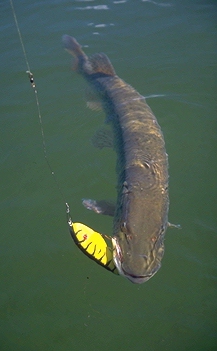|
Lure Colors and Muskies
(Courtesy of The Next Bite – ESOX Angler Magazine)
You’ve all seen the smiley tackle manufacturer or rep at the sports show, graciously offering info on their line of product; also counsel on the myriad of colors available. I’ve been there myself many times; on both sides of the fence. Once an angler is convinced they can’t possibly live without a particular lure type, the inevitable question is what color. It’s a tough one really. My standard reply as a manufacturer, of course, is-one of each.
I know, there’s plenty of moms, wives and non-fishers related or other-wise attached to esox nuts out there who can’t seem to understand why multiple overstuffed tackle boxes are a absolute necessity to pursue these fish; and considering monetary outlays, it’s a legit concern. We can get a little carried away with the “just-gotta-haves.” But in defense of lure junkies everywhere, I will unequivocally state that there is “some” validity in all of this. Colors do make a difference; sometimes it’s huge!
Is every single color in the line-up absolutely necessary? Probably not, but a good selection of colors in the chosen brand of each particular lure-type is actually not a bad idea. Certainly the confidence lures or those used consistently should be had in a variety of shades. Talk to a guy like Dick Pearson, who fishes many different bodies of water, and who, if he likes ‘em, gets to know them intimately … eventually productive color patterns for that body of water come up.
There are those lovely days when it seems to make little difference. The fish will hit any color. Some days even the type of lure makes little difference. But too often, the same lure in several colors will result in follows, while one specific pattern will be the only one that gets bit.
 The good news when fish are following … is that you are close! Although something is still not right. One or both of two factors “could” make the difference: sizing up or down in lure size and changing color. The good news when fish are following … is that you are close! Although something is still not right. One or both of two factors “could” make the difference: sizing up or down in lure size and changing color.
The “right” colors are certainly arguable. All I know for sure is, that the angler who sticks strictly to one or two favorite colors is definitely missing the boat much of the time. There may be valuable information available via tackle shops and local experts, but often just personal day-to-day experimentation is the key. With time, colors that consistently perform well on individual bodies of water can be noted. Consider also, that often colors that work well in one lure-type may not be as effective on another.
Or, a color that is hot on smaller lures may not work well on the same, significantly larger bait. It may just be too much of a good thing. Also consider that a large amount of run-off or a heavy algae bloom may change the water clarity enough to alter the most consistent colors’ consistency. The key is utilizing a variety of colors and simple time on  the water to figure out hot patterns for a given lake. This offers a great starting point and a definite advantage. Subtle changes can be made from there. the water to figure out hot patterns for a given lake. This offers a great starting point and a definite advantage. Subtle changes can be made from there.
One big mistake that I’ve made in the past, is to assume that a nearby water with very similar water clarity will find its muskies liking the same color patterns as the neighboring lake I was already familiar with. Definitely don’t count on that. Sometimes it works, but often it doesn’t. Be careful to not assume too much. The lakes may be amazingly similar, and yet effective color patterns during the same period may be nearly opposite. Keep an open mind and experiment.
In general, lures that are less erratic (straight retrieves) are lures that muskie are more likely to show specific color preferences for. Spinners lures seem to me to be the most color reliant. A good variety in your favorites is advisable.
Jerkbaits and crankbaits are somewhere in the middle. The more erratic the action, the less color will usually matter, but here too, experiment. I’ve seen drastic cases of color preferences with jerks too many times to ignore it. Even fast, make-‘em-mad-type retrieves, where you’d assume fish are strictly reacting to the action, can be ignored if the color isn’t right. Sorry mom, the junior muskie nut should have a pretty fair color selection in jerks and cranks (as he can afford, of course).
Now that I’ve probably created enemies of those closest to the severely addicted, I’ll make a few general suggestions … and maybe I’ll score a few points here with the first statement. Considering the fact that muskie lures are a far cry from free, don’t go rushing into a huge selection of every new item that initially tickles your fancy. Start with one. See if you really like it. Does it do what you expect? Are you confident it will work for you? Better yet, go out with a buddy that’s already been suckered into it and check theirs out. Often there’s someone around (lighter wallet) who has what you want to try.
But … and this is the bad news mom… when you find a lure you really like and have confidence in it, definitely get a good color selection. Basically, it’s not a bad idea to consider three or four natural patterns and three “gaudy” patterns. Naturals include stuff like perch, shad, walleye and bluegill. Gaudy means just that, bright stuff like chartreuse and orange.
Remember that on bodies of water that receive a lot of pressure, it often pays to just be different. If too many folks are tossing the same thing, fish may simply be getting dialed in to it. In general, natural patterns are usually better in clear water situations, but don’t be afraid to throw that real gaudy stuff. It can really be surprising.
There is no doubt that “hot” color patterns are a real phenomenon. Unfortunately they vary in effectiveness and length of life on given waters… but I guess that what keeps it fun…. sorry mom. |